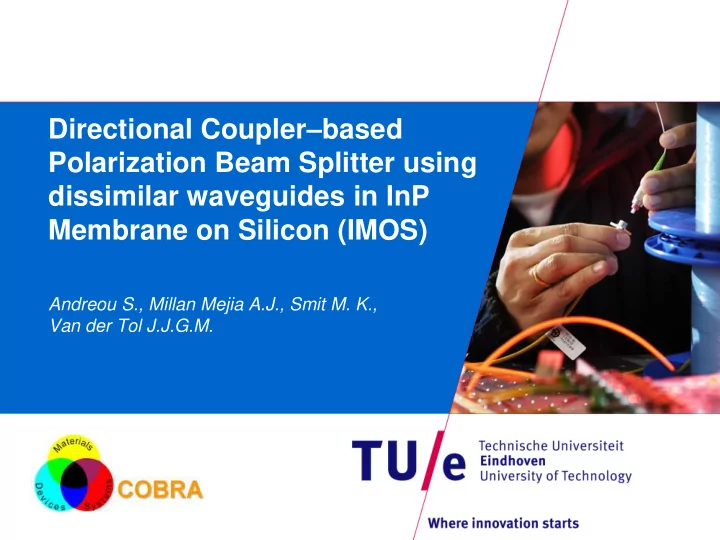

Directional Coupler – based Polarization Beam Splitter using dissimilar waveguides in InP Membrane on Silicon (IMOS) Andreou S., Millan Mejia A.J., Smit M. K., Van der Tol J.J.G.M.
Content 1. Introduction • InP Membrane On Silicon (IMOS) • Polarization Beam Splitters (PBS) • Slot waveguides 2. Coupled Mode Theory (CMT) 3. PBS structure 4. Simulation Results 5. Conclusions
InP Membrane On Silicon (IMOS) • New photonic integration platform • Photonic Membrane technology • InP Membrane: Optical layer • Silicon: Electronics below • High index contrast → high confinement • Light generation
Polarization Manipulation • Polarization can add functionalities to PICs • Effective manipulation of polarization states • Various PBS’s • Mach Zehnder • Directional Coupler • Mode evolution device
Slot waveguides • Geometrical birefringence n s n c n c n H n H • EM boundary conditions: • TE mode is strongly confined in the slot region (low index) x -a 0 a -b b • TM mode changes very slightly • Normal waveguide fabrication TE TM
Coupled Mode Theory (CMT) • Power is evanescently coupled from one waveguide to the other • Two system modes: even and odd • Power is completely coupled 𝝆 at 𝑴 𝒅 = 𝜸 𝒇 −𝜸 𝒑
Coupled Mode Theory (CMT) 1 Core 1, β 1 β 2 0.9 Core 2, β 1 β 2 0.8 Core 1, β 1 = β 2 Power in the two waveguides Core 2, β 1 = β 2 0.7 0.6 0.5 0.4 0.3 0.2 0.1 0 0 5 10 15 20 25 30 Length [um] • If 𝜸 𝒅𝒑𝒔𝒇 𝟐 − 𝜸 𝒅𝒑𝒔𝒇 𝟑 ≠ 𝟏 total power transfer cannot be achieved • One of the two polarization states should be completely transferred
Effective indices Normal waveguide Slot waveguide 2.1 1.8 1.75 2 1.7 1.9 1.65 1.8 1.6 N eff N eff 1.55 1.7 TE TE 1.5 1.6 TM TM 1.45 1.5 1.4 1.4 1.35 300 320 340 360 380 400 420 200 220 240 260 280 300 320 Waveguide width [nm] Ridges width [nm] • TM is roughly the same, TE substantially differs • For TM → Complete power transfer is possible • For TE → Complete power transfer is not possible
PBS Structure • TE → even number of Top View crossings Cross, TM → Coupling Region S-bend Length • TM → odd number of crossings • S-bend contributions are taken into account Input → Bar, TE→ Slot Ridge Waveguide Gap width width width Membrane Thickness SiO2 Coupling region cross section
Performance – FDTD Simulation 𝑴 𝒅 [ μ m] 25 TE 2.57 20 15 TM 5.4 10 5 [dB] Bar ER TE -TM 0 Cross -5 -10 Cross, TM → -15 -20 -25 1.5 1.51 1.52 1.53 1.54 1.55 1.56 1.57 1.58 1.59 1.6 Wavelength [um] 14 μ m Extinction ratio: 18 – 25dB Bar, TE→ Input → for the whole C - band
Fabrication Error Tolerance • Fabrication error: deviation 25 from design widths 20 15 10 • Extinction ratio >10dB for a [dB] 5 Bar ER TE - TM 0 Cross width deviation up to 30nm -5 -10 -15 • Acceptable for IMOS -20 platform -25 0 5 10 15 20 25 30 Fabrication error [nm]
Conclusions • A 14 μ m long PBS for membrane technology is proposed and simulated • The PBS exhibits high extinction ratio for the whole C – band • Fabrication comparable to normal waveguides • The device has acceptable fabrication tolerances • It can be used for polarization diverse applications
Recommend
More recommend